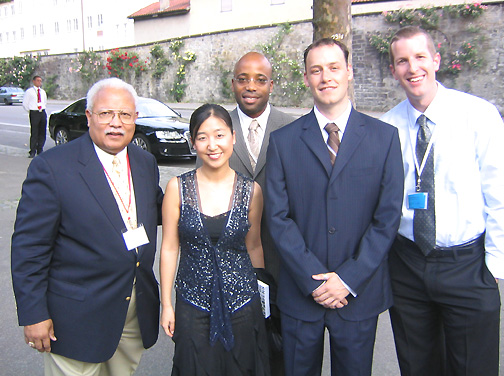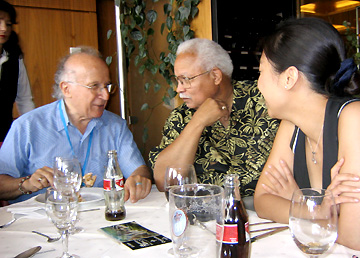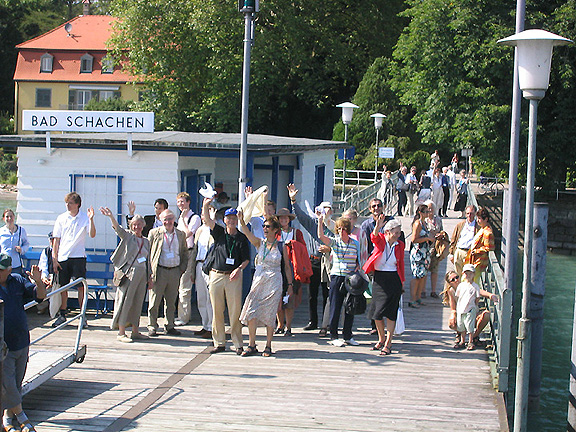
| T H E N I H C A T A L Y S T | S E P T E M B E R – O C T O B E R 2006 |
|
|
|
On Lindau Island
|
by Karen Ross |
 |
|
Wish
you were here:
(front row, left to right) NCRR Program Director Sidney
McNairy with GPP students Jean Lee, Steve Huffaker, and Andrew Patterson
(and behind them another lucky student) on site at Lindau
|
What do you get when you mix 500 student scientists from around the world with 20 Nobel laureates on Lindau, a tiny island in the middle of Germany’s Lake Constance?
The answer is the Lindau Meeting, a unique gathering that allows young scientists to get an up close and personal look at scientists who are leaders in their field. Three students from the NIH Graduate Partnerships Program (GPP)—Stephen Huffaker, Jean Lee, and Andrew Patterson—attended this year’s meeting, which featured Nobel laureates in chemistry.
The Lindau Meetings were founded by two physicians from Lindau—Gustav Parade and Franz Karl Hein—who wanted to establish a forum for Nobel laureates to meet with other scientists. With the help of Count Lennart Bernadotte af Wisborg, they held the first meeting for medical specialists in 1951.
Since then the topic of the meet-ing has rotated annually among the three natural science disciplines recognized by the Nobel Prize—physics, chemistry, and physiology or medicine.
In recent years, the Lindau Council has also sponsored meetings for Nobelists and students in economics. Countess Sonja Bernadotte, Count Bernadotte’s widow, is now the president of the council that oversees the meetings. She conducts the closing ceremonies, and a visit to her castle on Mainau Island, also in Lake Constance, is one of the highlights of the week-long conference.
At first, only German students participated, but today students from more than 20 countries attend, including a contingent of about 50 from the United States.
Students from the GPP participated in the Lindau Meeting for the first time this year, thanks to the impetus of Marshall Nirenberg, chief of the Laboratory of Biochemical Genetics in NHLBI and recipient of the 1968 Nobel Prize in physiology or medicine for his work on interpreting the genetic code.
 |
|
Table
Talk:
1981 Nobelist Roald Hoffmann (left), whose lecture was "almost poetry,"
chats with NCRR Program Director Sidney McNairy and GPP student Jean Lee
|
According to Richard McGee, the GPP’s Director of Graduate Student Affairs, Nirenberg approached GPP Director Mary Delong and asked, "Why aren’t GPP students going to this great event?" Delong took over from there, requesting nominations from the supervisors of GPP students and overseeing the selection process.
According to the Lindau Meeting website, students are invited to attend "as a reward for the quality of their performance and research work"—for which Huffaker, Lee, and Patterson were judged very well qualified.
This year’s Lindau Meeting was held June 26–30. In the mornings, students attended lectures presented by the Nobel laureates. Afternoons were devoted to discussion groups, in which students could meet 25–30 at a time with the laureates who had presented that morning.
Students and laureates ate meals together at nearby restaurants, and there were several social events that encouraged everyone to mingle. Huffaker, Lee, and Patterson were impressed by the personal stories that many of the laureates shared at the meeting. Some of the scientists had fled Europe during World War II and viewed their invitation to Lindau as a homecoming, said Lee. Several others spoke about their regret that their scientific careers had deprived them of time with their families, said Patterson. Huffaker was heartened to meet so many scientists "who were at the top of the game and are kindhearted."
"To see that it is possible to make it through and still remain a good person, that is an incredible experience," he said.
Peter Agre, who received the 2003 chemistry prize for his discovery of water channels known as aquaporins was a favorite of both Lee and Patterson. They were able to have a lengthy conversation with him after many of the other students had gone home. He was "very personable," says Patterson, and deeply interested in why so few young people in the United States seem to be interested in studying science. Lee found Agre to be "down to earth" and eager to talk about topics other than his research.
Lee and Patterson also enjoyed hearing from Walter Kohn. Kohn, the winner of the 1998 chemistry prize, did groundbreaking work on computer programs that simulate interactions among atoms in materials. However, the topic of his Lindau lecture was global warming. He showed a movie he produced about climate change that was narrated by John Cleese, of Monty Python fame, said Lee.
All three agreed that Roald Hoffmann, an expert on the mechanisms of chemical reactions and winner of the 1981 chemistry prize, gave one of the best talks. "His lecture was almost poetry," said Patterson. Hoffmann used his time at the Lindau Meeting to address the moral and ethical obligations of scientists.http://almaz.com/nobel/chemistry/1981b.html
Huffaker said of Hoffmann’s talk, "It was back to this Einstein model where a Nobel laureate is not just somebody who makes extremely large breakthroughs and contributions in science, but also ends up being a social role model."
 |
|
Dockside:
The Nobelist contingent waves adieu to Lindau and the students they inspired
as the meeting draws to a close
|
The U.S. students had many opportunities to talk to their counterparts from other countries. For Lee and Patterson, these conversations were a reminder of how lucky they have been to study at NIH, where resources are plentiful and responsibilities outside of research are minimal. "We’re spoiled," said Patterson.
"But we appreciate it," added Lee.
Asked if they would recommend the Lindau Meeting to other students, Huffaker, Lee, and Patterson were unreserved in their enthusiasm. Patterson said, "Absolutely. It was a completely unique experience."
Lee said, "It’s the only meeting I know that is specially geared to interactions between students and Nobel laureates."
Huffaker said, "[The originators] were spot on."
McGee would like other
GPP students to experience the Lindau Meeting for themselves. "By all means
we hope this becomes an annual event," he said. ![]()
| THE
RESEARCH PURSUITS OF THE GPP TRAVELERS |
|
Stephen Huffaker, who took part in one of the GPP’s International Partnerships, did research on schizophrenia under the supervision of Sabine Bahn at Cambridge University in England and Daniel Weinberger, chief of the Clinical Brain Disorders Branch, NIMH. By comparing gene-expression patterns in brain tissue from people with and without schizophrenia, he identified variant forms of two neighboring genes that may contribute to the disease. The products of these genes, Huffaker said, may be involved in "signal vs. noise processing" in the brain. This capability, which is thought to be defective in those with schizophrenia, allows the brain to pass useful information through complex neuronal circuits while minimizing the transmission of unnecessary chatter. Huffaker successfully defended his dissertation in July and will be attending Harvard Medical School in Boston this fall. |
|
|
Jean Lee, who is in the process of writing her dissertation, studies the immune response to HIV with Andrew McMichael at Oxford University and Daniel Douek of the Human Immunology Laboratory in the Vaccine Research Center. Using simian immunodeficiency virus infection of monkeys as a model system, she has investigated how the immune system handles a highly variable and constantly mutating virus. She is also using X-ray crystallography to discern the atomic structure of complexes between viral proteins and receptors on immune cells. Lee is part of an MD/PhD program sponsored by NIGMS and the NIH-Oxford program. Upon completing her dissertation, she will resume her medical studies at Albert Einstein Medical School in New York. |
|
|
Andrew Patterson completed his Ph.D. work on factors that regulate the synthesis of hemoglobin in February. He was part of the graduate program at George Washington University in Washington but did all of his research at NCI in the lab of Albert Fornace, who has since moved to Harvard University. Afterwards, Patterson moved one floor down in Building 37 to do postdoctoral work with Frank Gonzales in the Laboratory of Metabolism, NCI, on "metabolomics," tracking metabolic changes that occur in response to the stresses of diabetes or radiation exposure. His postdoctoral training is being funded by a competitively awarded Pharmacology Research Associate (PRAT) Fellowship. |